Copyright 2004 by Gail Gibbons All rights reserved Little, Brown and Company Hachette Book Group 237 Park Avenue New York, NY 10017 Visit our website at www.HachetteBookGroup.com www.twitter.com/littlebrown First eBook Edition: November 2009 ISBN: 978-0-316-09256-2
A Book about Ancient Egypt by GAIL GIBBONS

L ong, long ago, one of the worlds first civilizations began along the banks of the Nile. Travel back in time to when powerful pharaohs ruled over this land of golden palaces, huge stone monuments, and magnificent pyramids. Discover the scientific secrets of mummification, and learn about the language of hieroglyphics and how the Rosetta stone provided the clue to its meaning. The mysterious world of the ancient Egyptians is revealed in the pages of this fact-filled book.
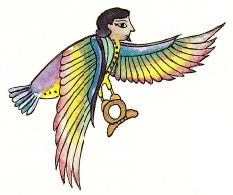
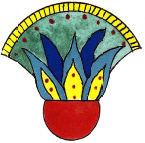
For Maria Modugno, my editor and friend, who rode a camel by the pyramids of Egypt
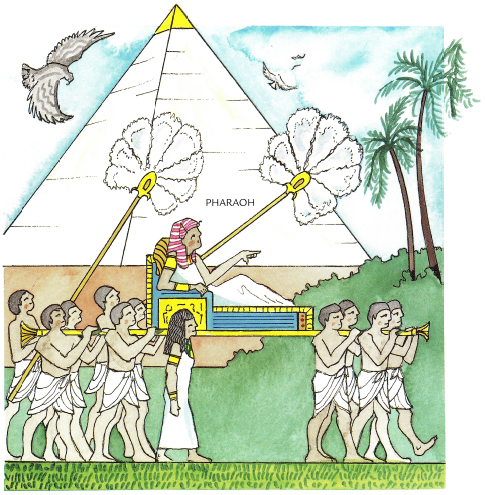
One of the worlds oldest continuous civilizations began about five thousand years ago, in the land of Egypt. For the next three thousand years the Egyptians were ruled by kings called pharaohs.
While he was in power, each pharaoh was believed to be Horus, the son of the great sun god, Re. 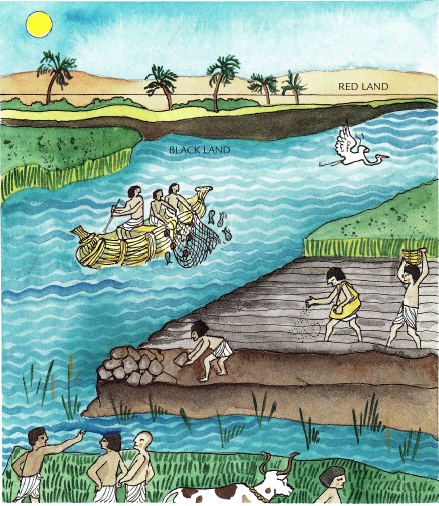 The ancient Egyptians lived in northeast Africa along the Nile River. They called the dark and fertile soil around the Nile the Black Land and used it for growing their crops.
The ancient Egyptians lived in northeast Africa along the Nile River. They called the dark and fertile soil around the Nile the Black Land and used it for growing their crops. 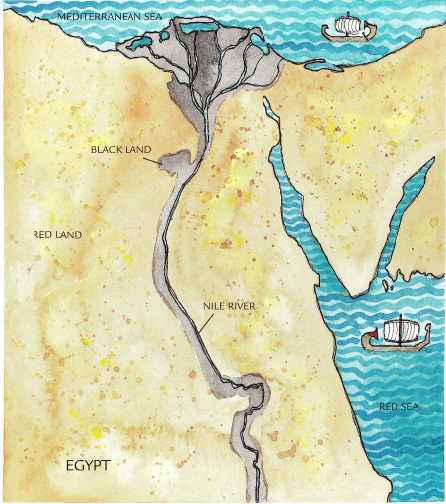 Beyond the dark soil was what the Egyptians called the Red Land. It was a huge, stony, red desert area where it rarely rained and few plants grew.
Beyond the dark soil was what the Egyptians called the Red Land. It was a huge, stony, red desert area where it rarely rained and few plants grew. 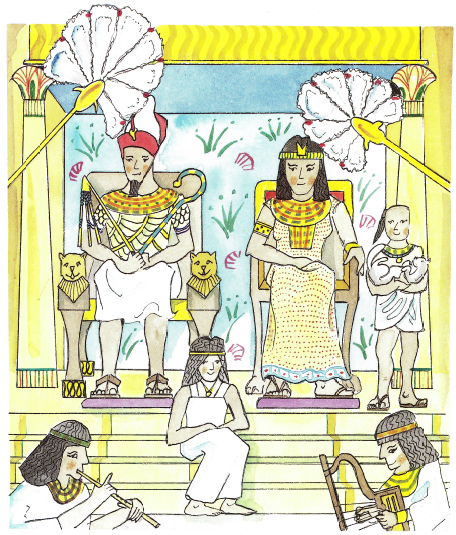 The pharaohs built Egypt into a rich and powerful nation.
The pharaohs built Egypt into a rich and powerful nation.
When a pharaoh died, his son inherited the throne. The wives of pharaohs were powerful, too, although only a few women ever ruled Egypt. 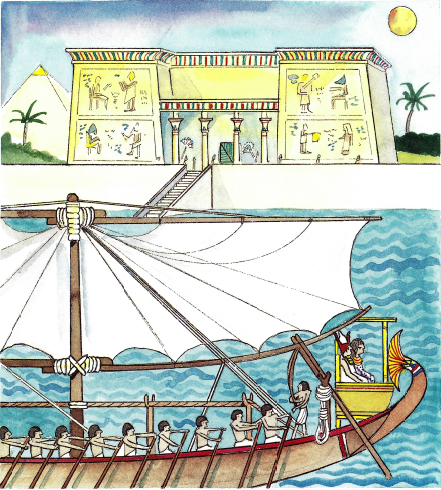 The royal couple often appeared in processions and celebrations, and took trips to the temples to worship their many gods. The pharaohs family dressed in rich fabrics decorated with gold and precious stones to display its wealth and power.
The royal couple often appeared in processions and celebrations, and took trips to the temples to worship their many gods. The pharaohs family dressed in rich fabrics decorated with gold and precious stones to display its wealth and power. 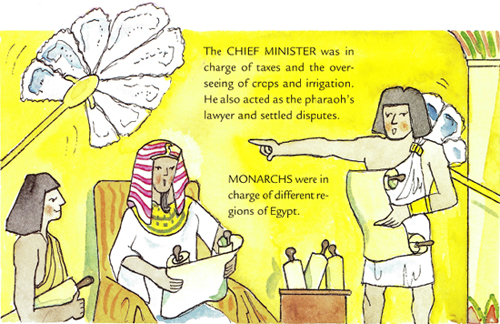 The TEMPLE PRIEST held religious ceremonies.
The TEMPLE PRIEST held religious ceremonies. 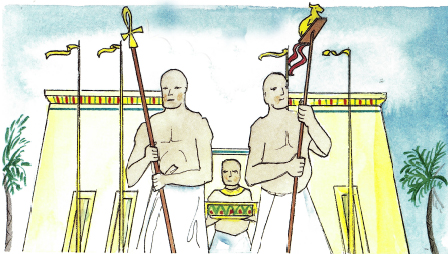 Ancient Egyptian society was highly organized.
Ancient Egyptian society was highly organized.
There were the very honored people. CRAFTSPEOPLE 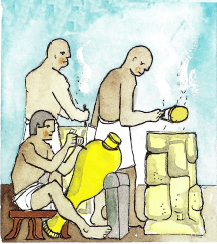 FARMERS
FARMERS 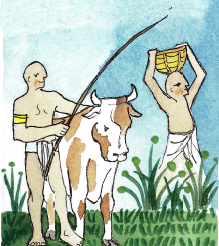 LABORERS
LABORERS 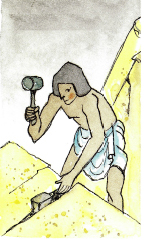 SOLDIERS
SOLDIERS 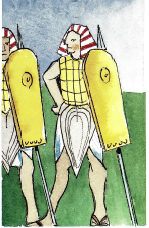 SLAVES
SLAVES 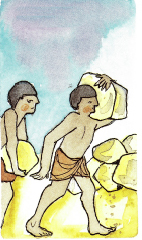 Most people worked for the pharaoh and the kingdom as craftspeople, farmers, or laborers. There were also soldiers, as well as slaves who had been captured during wars.
Most people worked for the pharaoh and the kingdom as craftspeople, farmers, or laborers. There were also soldiers, as well as slaves who had been captured during wars. 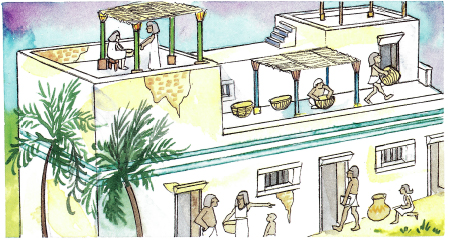
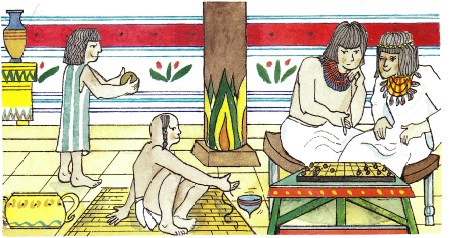 Most families lived in villages of sunbaked mud houses set close together. The houses had few windows, flat roofs, and square rooms with very little furniture. Wealthy families had servants and lived surrounded by beautiful objects.
Most families lived in villages of sunbaked mud houses set close together. The houses had few windows, flat roofs, and square rooms with very little furniture. Wealthy families had servants and lived surrounded by beautiful objects.
Ancient Egyptians loved perfumes. They rubbed scented oils on their skin to protect themselves from the dry climate, too. 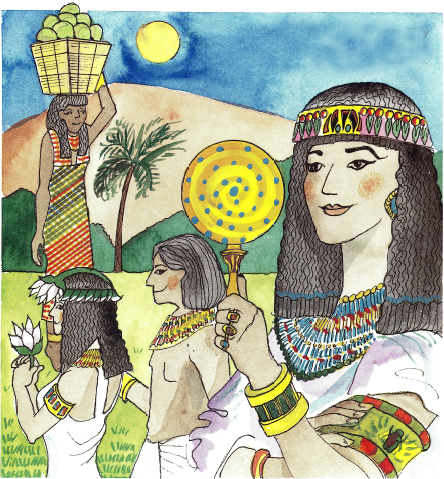 Because of the heat, ancient Egyptians wore light linen clothing. Most of the time the fabric was white. Slaves and servants, who came from foreign lands, wore patterned fabrics. Everyone cared greatly about how they looked.
Because of the heat, ancient Egyptians wore light linen clothing. Most of the time the fabric was white. Slaves and servants, who came from foreign lands, wore patterned fabrics. Everyone cared greatly about how they looked.
Men and women, both rich and poor, owned jewelry and used makeup, especially eye paint. 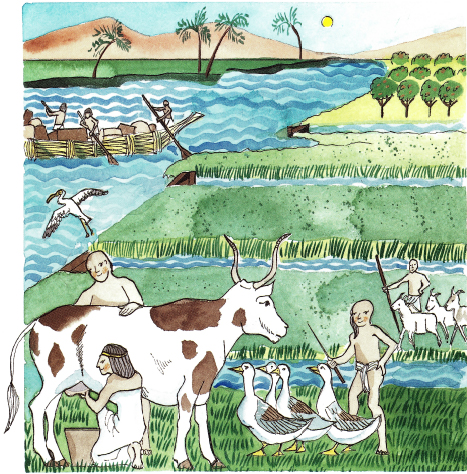 Farmers depended on water from the Nile to grow their crops. During the growing season canals carried water to the fields. This is called irrigation. The farmers grew barley, wheat, fruit, and vegetables.
Farmers depended on water from the Nile to grow their crops. During the growing season canals carried water to the fields. This is called irrigation. The farmers grew barley, wheat, fruit, and vegetables. 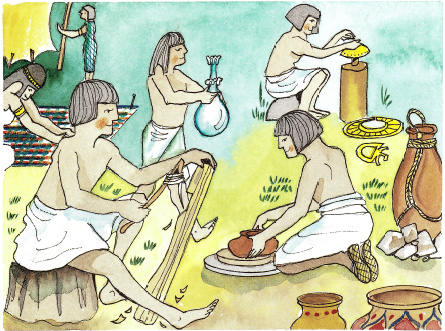 Egyptian paintings told stories about living people, and also about what they hoped to see when they died and met their gods.
Egyptian paintings told stories about living people, and also about what they hoped to see when they died and met their gods. 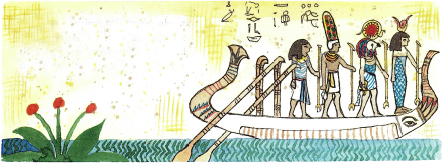 The craftspeople included potters, carpenters, glassmakers, leather workers, jewelers, and weavers.
The craftspeople included potters, carpenters, glassmakers, leather workers, jewelers, and weavers.  The craftspeople included potters, carpenters, glassmakers, leather workers, jewelers, and weavers.
The craftspeople included potters, carpenters, glassmakers, leather workers, jewelers, and weavers.
Copper and gold were plentiful in Egypt and were used in many art forms. The ROSETTA STONE was the key to modern scholars understanding of Egyptian picture writing. Because it was written both in hieroglyphs and in Greek, historians were able to learn details of the religion, laws, and everyday lives of ancient Egyptians. The ROSETTA STONE was found in 1799 by a French soldier near the Egyptian village of Rosetta. 
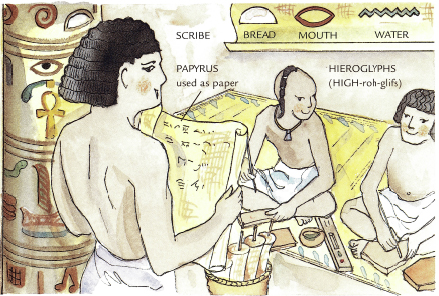

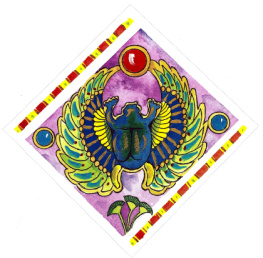
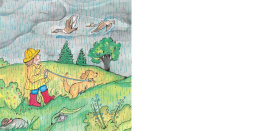

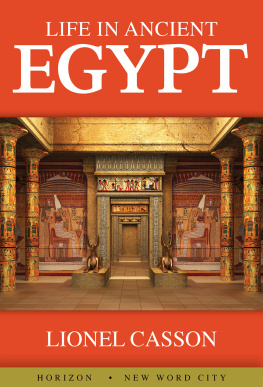
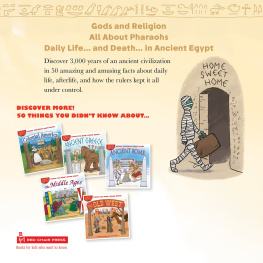


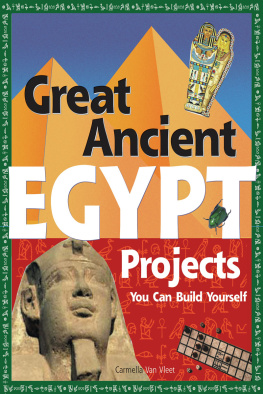
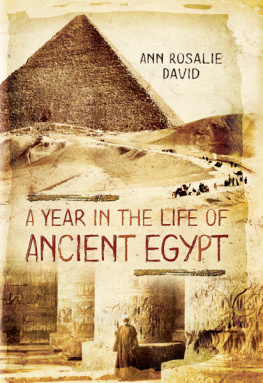
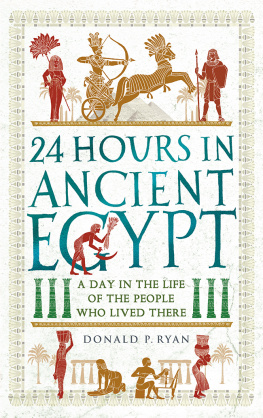

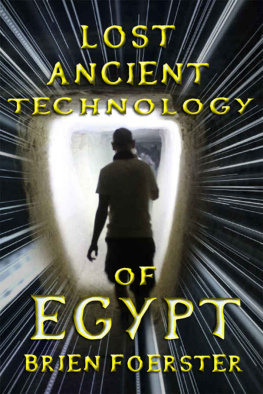
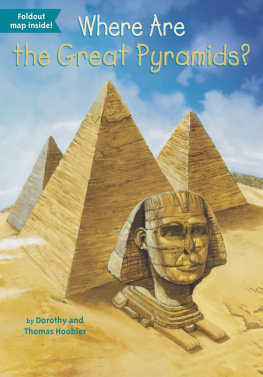
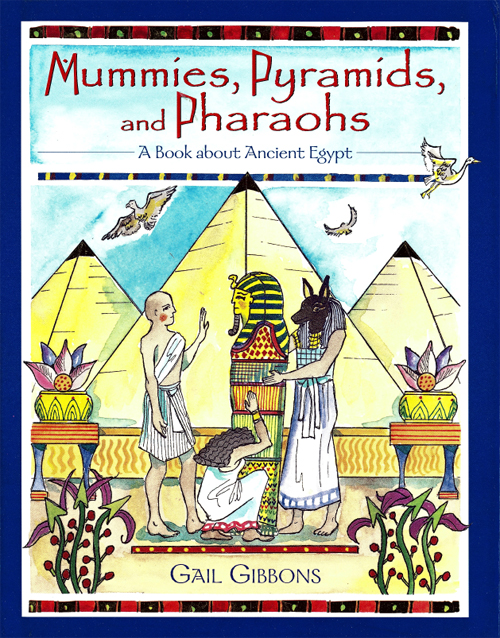
 L ong, long ago, one of the worlds first civilizations began along the banks of the Nile. Travel back in time to when powerful pharaohs ruled over this land of golden palaces, huge stone monuments, and magnificent pyramids. Discover the scientific secrets of mummification, and learn about the language of hieroglyphics and how the Rosetta stone provided the clue to its meaning. The mysterious world of the ancient Egyptians is revealed in the pages of this fact-filled book.
L ong, long ago, one of the worlds first civilizations began along the banks of the Nile. Travel back in time to when powerful pharaohs ruled over this land of golden palaces, huge stone monuments, and magnificent pyramids. Discover the scientific secrets of mummification, and learn about the language of hieroglyphics and how the Rosetta stone provided the clue to its meaning. The mysterious world of the ancient Egyptians is revealed in the pages of this fact-filled book. 
 For Maria Modugno, my editor and friend, who rode a camel by the pyramids of Egypt
For Maria Modugno, my editor and friend, who rode a camel by the pyramids of Egypt  One of the worlds oldest continuous civilizations began about five thousand years ago, in the land of Egypt. For the next three thousand years the Egyptians were ruled by kings called pharaohs.
One of the worlds oldest continuous civilizations began about five thousand years ago, in the land of Egypt. For the next three thousand years the Egyptians were ruled by kings called pharaohs.  The ancient Egyptians lived in northeast Africa along the Nile River. They called the dark and fertile soil around the Nile the Black Land and used it for growing their crops.
The ancient Egyptians lived in northeast Africa along the Nile River. They called the dark and fertile soil around the Nile the Black Land and used it for growing their crops.  Beyond the dark soil was what the Egyptians called the Red Land. It was a huge, stony, red desert area where it rarely rained and few plants grew.
Beyond the dark soil was what the Egyptians called the Red Land. It was a huge, stony, red desert area where it rarely rained and few plants grew.  The pharaohs built Egypt into a rich and powerful nation.
The pharaohs built Egypt into a rich and powerful nation. The royal couple often appeared in processions and celebrations, and took trips to the temples to worship their many gods. The pharaohs family dressed in rich fabrics decorated with gold and precious stones to display its wealth and power.
The royal couple often appeared in processions and celebrations, and took trips to the temples to worship their many gods. The pharaohs family dressed in rich fabrics decorated with gold and precious stones to display its wealth and power.  The TEMPLE PRIEST held religious ceremonies.
The TEMPLE PRIEST held religious ceremonies.  Ancient Egyptian society was highly organized.
Ancient Egyptian society was highly organized. FARMERS
FARMERS  LABORERS
LABORERS  SOLDIERS
SOLDIERS  SLAVES
SLAVES  Most people worked for the pharaoh and the kingdom as craftspeople, farmers, or laborers. There were also soldiers, as well as slaves who had been captured during wars.
Most people worked for the pharaoh and the kingdom as craftspeople, farmers, or laborers. There were also soldiers, as well as slaves who had been captured during wars. 
 Most families lived in villages of sunbaked mud houses set close together. The houses had few windows, flat roofs, and square rooms with very little furniture. Wealthy families had servants and lived surrounded by beautiful objects.
Most families lived in villages of sunbaked mud houses set close together. The houses had few windows, flat roofs, and square rooms with very little furniture. Wealthy families had servants and lived surrounded by beautiful objects. Because of the heat, ancient Egyptians wore light linen clothing. Most of the time the fabric was white. Slaves and servants, who came from foreign lands, wore patterned fabrics. Everyone cared greatly about how they looked.
Because of the heat, ancient Egyptians wore light linen clothing. Most of the time the fabric was white. Slaves and servants, who came from foreign lands, wore patterned fabrics. Everyone cared greatly about how they looked. Farmers depended on water from the Nile to grow their crops. During the growing season canals carried water to the fields. This is called irrigation. The farmers grew barley, wheat, fruit, and vegetables.
Farmers depended on water from the Nile to grow their crops. During the growing season canals carried water to the fields. This is called irrigation. The farmers grew barley, wheat, fruit, and vegetables.  Egyptian paintings told stories about living people, and also about what they hoped to see when they died and met their gods.
Egyptian paintings told stories about living people, and also about what they hoped to see when they died and met their gods.  The craftspeople included potters, carpenters, glassmakers, leather workers, jewelers, and weavers.
The craftspeople included potters, carpenters, glassmakers, leather workers, jewelers, and weavers. 
